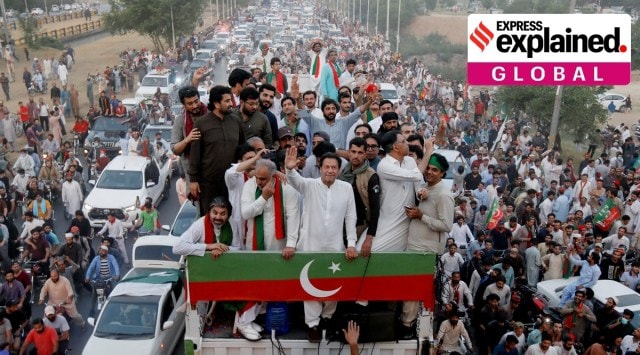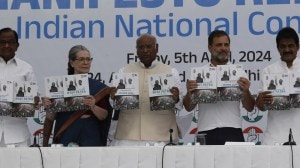- India
- International
Explained: A short history of Pakistan’s many long marches
Imran Khan has given the government of Shehbaz Sharif 6 days to call fresh elections, failing which he will bring the 'entire nation' to Pakistan. Street power has long played an important role in Pakistan’s political history, with thousands of protesters coordinating to periodically lay siege to Islamabad.
 Ousted Pakistani Prime Minister Imran Khan gestures as he travels on a vehicle to lead a protest march in Islamabad, Thursday. (REUTERS)
Ousted Pakistani Prime Minister Imran Khan gestures as he travels on a vehicle to lead a protest march in Islamabad, Thursday. (REUTERS)Imran Khan disbanded a protest march by his supporters on Thursday (May 26) after clashes with police outside Pakistan’s Parliament, but threatened to “return” to Islamabad with the “entire nation” unless the government of Prime Minister Shehbaz Sharif called an election within six days.
On Thursday morning, workers and supporters of Imran’s Pakistan Tehreek-e-Insaf (PTI) entered Islamabad’s Red Zone where they were being stopped by police, the Pakistan Rangers, and other law enforcers with “patience”, Dawn reported, quoting a police spokesperson. The Red Zone contains important government buildings such as Pakistan’s Parliament, Supreme Court, the Prime Minister’s Office, and the Secretariat.
Buy Now | Our best subscription plan now has a special price
Earlier on Wednesday, the Pakistani government had blockaded all major roads leading to the capital, after the former Prime Minister issued a clarion call to his supporters to march to Islamabad.
Imran’s own convoy had entered Punjab from Attock on Wednesday evening, after his supporters removed barricades placed by the government on the Attock bridge, media reports from the country said.

Imran had announced his long march on Sunday (May 22) to demand the immediate dissolution of the National Assembly and a date for new general elections. Since he was ousted by a parliamentary vote of no-confidence in April, Imran has sought to put pressure on the Sharif regime by holding rallies across the country that have drawn massive crowds.
Street power has played an important role in Pakistan’s political history, with political opponents, civil society groups, and at times the country’s masses as a whole occupying key cities like Islamabad. Long marches, particularly over the past two decades, have come to be the catalyst that has led to change in the government.
Underlying this tradition is the belief that changing political representatives can lead to some kind of overall political transformation. Ironically, however, the leaders who have been at the forefront of the street movements have often ended up facing such movements themselves.
Here’s a look at some significant “long marches” in Pakistan’s history.
Early political protests
* Popular protests and demonstrations are not a new phenomenon in Pakistan. In 1968, one of the first mass uprisings — which included 10-15 million students and workers — erupted against the regime of the military dictator Ayub Khan. Facing immense pressure, Ayub Khan was forced to resign in 1969.
* In 1977, an important demonstration was launched by the Pakistan National Alliance (PNA), which sought the removal of Prime Minister Zulfiqar Ali Bhutto. It eventually resulted in the removal of Bhutto by a military coup, under the orders of General Zia ul-Haq.
* The first major protest in Islamabad took place in July 1980. Dawn reported that demonstrators from Pakistan’s minority Shia community, led by Mufti Jaafar Hussain, besieged the federal secretariat in response to the implementation of the Zakat and Ushr Ordinance by Zia’s government.
They were protesting against the “enforced deduction” of zakat (religious charity/ tax), and eventually the dictator succumbed to their demands and excluded Shias from the tax.
Lawyers’ marches: 2007-09
On 9 March 2007, General Pervez Musharraf unconstitutionally suspended the Chief Justice of Pakistan Iftikhar Muhammad Chaudhry. This resulted in the first long march to Islamabad, with Justice Chaudhary and lawyer leaders demanding his reinstatement.
Chaudhry’s suspension led to fierce opposition from the lawyer community who organized the Adliya Bachao Tehreek (Save the Judiciary Movement), with around 80,000 lawyers joining hands to demand the reinstatement of Chaudhry and the restoration of judicial independence.
While Chaudhry was reinstated following the protests, in November 2007 Musharraf imposed an emergency in the country and the Chief Justice was removed once more, along with 60 other judges.
This was not the end of the movement. In June 2008, the lawyer community once again hit the road in a long march to Islamabad. The purpose of the four-day march was to demand the resignation of Musharraf and the reinstatement of the 60 other judges who were deposed during the 2007 Emergency rule. The lawyers were joined by political activists and civil society organisations; an estimated 500,000 people took part in the movement.
The movement also shaped the political landscape of Pakistan. The 2008 elections saw the resurgence of the two major parties, the Pakistan Peoples’ Party (PPP) and the Pakistan Muslim League-Nawaz (PML-N). In the wake of mass discontent, Musharraf resigned the following year.
The new government led by the PPP, and with Asif Ali Zardari as President, did not reinstate the judges, however. The lawyers started their protest again in 2009, culminating in a nationwide long march to Islamabad. This protest was led by Nawaz Sharif, whose party, the PML-N had withdrawn from the government.
The march ended in Gujranwala, before it could reach the capital, after Prime Minister Yousaf Raza Gilani announced that Chaudhry and the 60 other judges would be reinstated in their positions.
2014 Azadi March
On August 14, Pakistan’s 67th Independence Day, Imran Khan’s PTI launched the Azadi March. The massive rallies that began from Lahore and ended in Islamabad were driven by accusations that the PML(N) had rigged the general election in May 2013.
The movement, which demanded the resignation of Prime Minister Sharif, lasted for a record 126 days and received non-stop media coverage. The protest was not restricted to PTI party workers, it included substantial participation of women, students, and the Pakistani masses. More than a million people are said to have taken part in the Azadi March.
Imran’s popularity surged on the support of the youth, who were disillusioned with the existing political system. He was joined by the cleric Muhammad Tahir-ul Qadri, who had led protests in January 2013 against Zardari. Qadri, who usually resided in Canada, formed an informal alliance with Imran for the 2014 protests.
On December 17, 2014, a day after the horrific terrorist attack on a school in Peshawar by the Pakistan Taliban, in which almost 150 people were killed, the Azadi March was called off.
The 2014 long march was striking due to its extended duration and mass participation. It propelled Imran’s political career, and ultimately led to him becoming Prime Minister with the Army’s backing in August 2018.
Newsletter | Click to get the day’s best explainers in your inbox
Imran Khan’s struggles
In 2019, Maulana Fazl-ur-Rehman of the Jamiat Ulema-e-Islam (F) held his own long march against Imran, with tens of thousands of his male supporters descending on Islamabad. The protesters demanded Imran’s resignation due to the country’s growing economic crisis. The protest however, lasted for only two weeks, and Imran continued to hold on to his seat.
This would be the beginning of Imran’s political crisis. In October 2020, the Pakistan Democratic Movement (PMD), an alliance of 11 opposition parties, launched their own anti-government demonstration in Gujranwala.
In February-March 2022, Bilawal Bhutto-Zardari of the PPP began his “Awami March” against Imran, a 10-day protest that moved through 34 cities before finally culminating in Islamabad.
More Explained
EXPRESS OPINION
Apr 25: Latest News
- 01
- 02
- 03
- 04
- 05










































